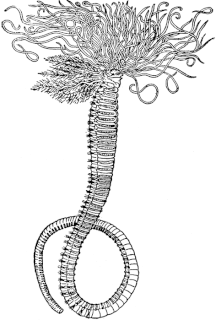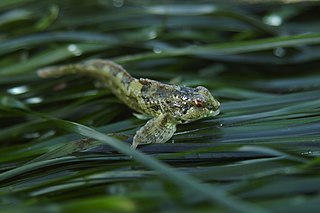
The Polychaeta, also known as the bristle worms or polychaetes, are a paraphyletic class of annelid worms, generally marine. Each body segment has a pair of fleshy protrusions called parapodia that bear many bristles, called chaetae, which are made of chitin. More than 10,000 species are described in this class. Common representatives include the lugworm and the sandworm or clam worm Alitta.
Chasmodes saburrae, the Florida blenny, is a species of combtooth blenny found in the western central Atlantic Ocean, around the coast of the United States.

The seaweed blenny is a species of combtooth blenny found in coral reefs in the western Atlantic Ocean along the coasts of New York, Bermuda, the Bahamas, also in the Gulf of Mexico, south to southern Brazil. This species reaches a length of 8.5 centimetres (3.3 in) TL.

Odontosyllis enopla, commonly known as the Bermuda fireworm, is a polychaete worm that inhabits shallow areas of the western Atlantic Ocean. The organism is bioluminescent when it rises to the surface of the sea during its mating period. It is possible that this fireworm is the explanation of a candle-like light seen by Christopher Columbus during his first voyage on 11 October 1492 before he made landfall in his explorations.

Amphitrite ornata or ornate worm, is a species of marine polychaete worm in the family Terebellidae.

Serpula vermicularis, known by common names including the calcareous tubeworm, fan worm, plume worm or red tube worm, is a species of segmented marine polychaete worm in the family Serpulidae. It is the type species of the genus Serpula and was first described by Carl Linnaeus in his 1767 12th edition of Systema Naturae. It lives in a tube into which it can retract.
Haplosyllis spongicola, the sponge worm, is a species of polychaete worm in the family Syllidae. It was previously classified as Syllis spongicola and is part of a species complex of closely related species that are difficult to distinguish morphologically and where the demarcation between them is unclear. It is found in shallow temperate, subtropical and tropical seas worldwide, wherever its host sponges are found.

Alpheus heterochaelis, the bigclaw snapping shrimp, is a snapper or pistol shrimp in the family Alpheidae. It is found in the western Atlantic Ocean and the Gulf of Mexico.

Eulalia viridis is a species of bright-green polychaete worm in the family Phyllodocidae. It can range from 5 to 15 cm in length and is usually found in shallow north Atlantic water under rocks or in mussel beds.
Amathia vidovici is a species of colonial bryozoans with a tree-like structure. It is found in shallow waters over a wide geographical range, being found in both the Atlantic and Pacific Oceans and adjoining seas.

Hediste diversicolor, commonly known as a ragworm, is a polychaete worm in the family Nereidae. It lives in a burrow in the sand or mud of beaches and estuaries in intertidal zones in the north Atlantic. This species is used in research but its classification is in dispute and in the literature it is often classified as Nereis diversicolor. Its specific name "diversicolor" refers to the fact that its colour changes from brown to green as the breeding season approaches.

Sabella spallanzanii is a species of marine polychaete worms in the family Sabellidae. Common names include the Mediterranean fanworm, the feather duster worm, the European fan worm and the pencil worm. It is native to shallow waters in the northeastern Atlantic Ocean and the Mediterranean Sea. It has spread to various other parts of the world and is included on the Global Invasive Species Database.
Osedax japonicus is a species of bathypelagic polychaete tube worm that lives at great depths on the seabed and is able to sustain itself on the bones of a dead whale. It was first described in 2006 from a sunken sperm whale carcase near Kyushu, Japan.

The tidepool sculpin is a fish species in the sculpin family Cottidae that ranges from the Bering Sea to southern California. Individuals reach up to 8 cm (3 in) in length and are common in tidepools.

Phyllodoce mucosa is a species of polychaete worm in the family Phyllodocidae. It is found intertidally in both the Pacific and Atlantic Oceans, typically on sandy or muddy seabeds.

Phyllodoce maculata is a species of Polychaete worm in the family Phyllodocidae. It is native to the northeastern Atlantic Ocean where it inhabits shallow water areas of sand, mud and stones.
Eulalia clavigera is a species of polychaete worm in the family Phyllodocidae, native to the coasts around Britain, through Western France, and to the Iberian Peninsula. It closely resembles Eulalia viridis, and there has been confusion in the past as to the identification of the two species.

Syllis ramosa is a species of polychaete worm in the family Syllidae. It is found in the deep sea where it lives within the tissues of a sponge. It was the first branching polychaete worm to be discovered, with each worm having a single head and multiple anuses.

Ramisyllis multicaudata is a species of polychaete worm in the family Syllidae. It was found in Darwin Harbour, Australia, where it was living within the tissues of a sponge of the genus Petrosia. It was the second branching species of polychaete worm to have been discovered, the first having been Syllis ramosa, a deep water species, more than a century earlier.

Phyllodoce lineata is a species of polychaete worm in the family Phyllodocidae. It is native to the northeastern Atlantic Ocean and the Mediterranean Sea where it occurs in the intertidal and shallow sub-tidal zones on soft sediment.















